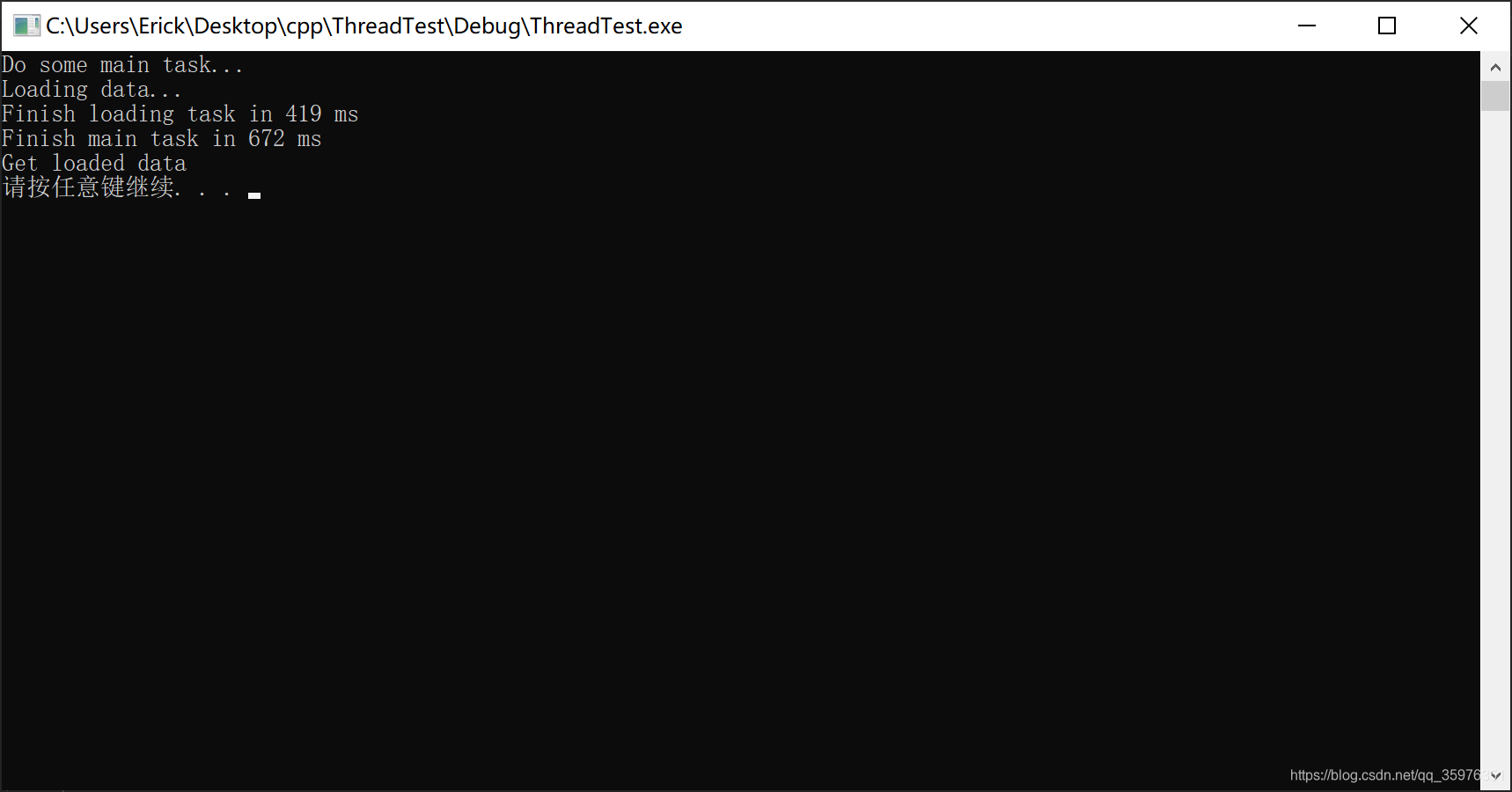关于互斥量std::mutex的总结
互斥量用于组成代码的临界区。C++的多线程模型是基于内存的,或者说是基于代码片段的,这和我们操作系统学习的临界区概念基本一致,但是与Golang不同,Golang是基于消息模型的。
一个std::mutex的lock()和unlock()之间的代码片段组成一个临界区,这个临界区内部同时最多只能有一个线程进行访问,可以理解为这个片段内部的代码是受到保护的,不会被多线程同时访问造成不可预知的问题。
std::mutex mtx;
mtx.lock();
// 这里的代码,同时最多只能有一个线程进行访问
mtx.unlokc();
当一个线程获取到一个std::mutex并且调用lock()后,必须由同一个线程调用unlock()操作,因此一定要注意两个函数成对出现,否则会造成死锁。
当一个线程获取一个std::mutex并调用lock()函数后,其他线程的调用会失败。可以使用try_lock进行判别,具体细节参考:https://en.cppreference.com/w/cpp/thread/mutex
关于std::lock_guard和std::unique_lock的总结
std::lock_guard比较好理解,因为调用mutex需要时刻记着解锁,所用这个类封装了一系列的操作,在一个模块中构造了一个std::lock_guard后,相当于对该结构块加锁,当线程离开结构块后,std::lock_guard自动析构,相当于解锁。它的结构简单、速度快,但是功能比较少。
std::unique_lock是对std::lock_guard功能的一个拓展,功能更多,但是速度会慢一些,具体参照:https://en.cppreference.com/w/cpp/thread/unique_lock
关于条件变量std::condition_variable的总结
这个相当于操作系统中的wait和signal原语操作,需要结合一个std::unique_lock组成的临界区共同完成功能。wait & signal原语操作最典型的特点是 “阻塞自己,唤醒别人”。可以这么理解,如果当前满足特定条件不满足,那么就不能进入临界区,当前线程阻塞。当其他线程处理完后,使得条件满足了,线程会唤醒那些处于阻塞状态的线程,使之重新进入。直接通过下面的代码来说明,经典的生产者和消费者问题。
注意只有一个互斥量的时候,唤醒顺序的问题,参照官网:https://en.cppreference.com/w/cpp/thread/condition_variable
在这里给出一个更加简洁的例子:
void worker_thread()
{
// Wait until main() sends data
std::unique_lock<std::mutex> lk(m);
cv.wait(lk, pred});
// 这里执行工作代码,注意下面两个语句的顺序
lk.unlock();
cv.notify_one();
}
上述代码中,先执行lk.unlock(),说明当前线程放弃对临界区的所有权,此时再调用notify_one会唤醒其他线程来对临界区执行操作。如果先唤醒其他线程,则可能unlock未执行完毕,就有线程到临界区了,此时新来的线程又会阻塞了。
代码示例
下面代码总共是3个例子。第一个Application是模拟一个事件处理系统的,但是没有使用条件变量,自己实现了一下,第二个Application使用了条件变量。第三个ProduceAndConsume是典型的生产者和消费者模型。

未使用条件变量,仅仅借助循环的加载数据应用
#include <iostream>
#include <thread>
#include <mutex>
#include <condition_variable>
#include <functional>
#include <chrono>
#include <random>
#include <cstdlib>
const int MAXT = 1000;
std::uniform_int_distribution<int>dis(1, MAXT);
std::random_device rd;
std::mt19937 gen(rd());
class Application {
public:
void mainTask() {
std::cout << "Do some main task...\n";
auto t = dis(gen); // 随机时间模拟主线任务
std::this_thread::sleep_for(std::chrono::milliseconds(t));
std::cout << "Finish main task in " << t << " ms\n";
mtx.lock();
while (!m_bDataLoaded) {
mtx.unlock();
std::this_thread::sleep_for(std::chrono::microseconds(100));
mtx.lock();
}
mtx.unlock();
std::cout << "Get loaded data\n";
}
void loadData() {
std::cout << "Loading data...\n";
auto t = dis(gen); // 随机时间模拟主线任务
std::this_thread::sleep_for(std::chrono::milliseconds(t));
std::lock_guard<std::mutex>lck(mtx);
m_bDataLoaded = true;
std::cout << "Finish loading data in " << t << " ms\n";
}
bool isDataLoaded()const {
return m_bDataLoaded;
}
private:
bool m_bDataLoaded{ false };
std::mutex mtx;
std::condition_variable m_convVar;
};
int main() {
Application app;
std::thread t1(&Application::mainTask, &app);
std::thread t2(&Application::loadData, &app);
t1.join();
t2.join();
system("pause");
return 0;
}
结果:
使用了条件变量的加载数据应用
#include <iostream>
#include <thread>
#include <mutex>
#include <condition_variable>
#include <functional>
#include <chrono>
#include <random>
#include <cstdlib>
const int MAXT = 1000;
std::uniform_int_distribution<int>dis(1, MAXT);
std::random_device rd;
std::mt19937 gen(rd());
class Application {
public:
void mainTask() {
std::cout << "Do some main task...\n";
auto t = dis(gen); // 随机时间模拟主线任务
std::this_thread::sleep_for(std::chrono::milliseconds(t));
std::cout << "Finish main task in " << t << " ms\n";
std::unique_lock<std::mutex> lck(mtx);
m_convVar.wait(lck, std::bind(&Application::isDataLoaded, this));
std::cout << "Get loaded data\n";
}
void loadData() {
std::cout << "Loading data...\n";
auto t = dis(gen); // 随机时间模拟加载数据任务
std::this_thread::sleep_for(std::chrono::milliseconds(t));
std::cout << "Finish loading task in " << t << " ms\n";
std::unique_lock<std::mutex> lck(mtx);
m_bDataLoaded = true;
lck.unlock(); // 最好是添加上这一句,本例子无所谓
m_convVar.notify_one();
}
bool isDataLoaded()const {
return m_bDataLoaded;
}
private:
bool m_bDataLoaded{ false };
std::mutex mtx;
std::condition_variable m_convVar;
};
int main() {
Application app;
std::thread t1(&Application::mainTask, &app);
std::thread t2(&Application::loadData, &app);
t1.join();
t2.join();
system("pause");
return 0;
}
运行结果:
生产者和消费者模型
#include <iostream>
#include <thread>
#include <mutex>
#include <condition_variable>
#include <chrono>
#include <random>
#include <functional>
#include <algorithm>
#include <queue>
#include <vector>
#include <cstdlib>
const int MAXT = 1000;
const int MAXN = 5;
std::random_device rd;
std::mt19937 gen(rd());
std::uniform_int_distribution<int>dis(MAXT / 10, MAXT);
class ProducerAndConsumer {
public:
void prodece() {
// 随机时间,模拟货物生产过程,生产过程本身不是在临界区
std::this_thread::sleep_for(std::chrono::milliseconds(2 * dis(gen)));
std::cout << "Prodece\n";
std::unique_lock<std::mutex> lck(mtx);
m_convPro.wait(lck, std::bind(&ProducerAndConsumer::notFull, this));
m_qCargo.push(m_iCargoNum);
++m_iCargoNum;
m_convCon.notify_one();
}
void consume() {
std::unique_lock<std::mutex> lck(mtx);
m_convCon.wait(lck, std::bind(&ProducerAndConsumer::notEmpty, this));
int n = m_qCargo.front();
m_qCargo.pop();
m_convPro.notify_one();
lck.unlock(); // 一定要先解锁
// 随机时间,模拟货物消费过程,消费过程本身不是在临界区!!!
std::this_thread::sleep_for(std::chrono::milliseconds(dis(gen)));
std::cout << "Consume\n";
}
inline bool notFull()const {
return m_qCargo.size() < m_iMaxCargoNum;
}
inline bool notEmpty()const {
return m_qCargo.size() > 0;
}
inline int getBufferSize()const {
return m_qCargo.size();
}
inline int getCargoNum()const {
return m_iCargoNum;
}
private:
std::queue<int> m_qCargo; // 货物队列
int m_iMaxCargoNum{ MAXN }; // 最大容量
int m_iCargoNum{ 0 }; // 货物总数
std::mutex mtx;
std::condition_variable m_convPro, m_convCon;
};
int main() {
ProducerAndConsumer pac;
auto N = std::thread::hardware_concurrency();
std::cout << "Thread num: " << N << std::endl;
std::vector<std::thread>producerThreads;
std::vector<std::thread>consumerThreads;
for (int i = 0; i < N; ++i) {
producerThreads.emplace_back(std::thread(&ProducerAndConsumer::prodece, &pac));
consumerThreads.emplace_back(std::thread(&ProducerAndConsumer::consume, &pac));
}
std::for_each(producerThreads.begin(), producerThreads.end(),
std::mem_fn(&std::thread::join));
std::for_each(consumerThreads.begin(), consumerThreads.end(),
std::mem_fn(&std::thread::join));
std::cout << "Cargo in buffer: " << pac.getBufferSize() << std::endl;
std::cout << "Cargo count: " << pac.getCargoNum() << std::endl;
system("pause");
return 0;
}
运行结果:
